Molecular Diagnostics Market Size 2024-2028
The molecular diagnostics market size is forecast to increase by USD 7.92 billion, at a CAGR of 5.84% between 2023 and 2028.
Major Market Trends & Insights
- Asia dominated the market and accounted for a 38% growth during the forecast period.
- By the Product - Instruments segment was valued at USD 14.84 billion in 2022
- By the Application - Infectious diseases segment accounted for the largest market revenue share in 2022
Market Size & Forecast
- Market Opportunities: USD 61.37 million
- Market Future Opportunities: USD 7918.70 million
- CAGR : 5.84%
- Asia: Largest market in 2022
Market Summary
- The market is experiencing significant growth, with a notable increase in the adoption rate of advanced technologies such as next-generation sequencing (NGS). According to market reports, The market is projected to reach a value of USD32.2 billion by 2025, growing at a steady pace. This expansion can be attributed to the rising prevalence of chronic diseases, the growing demand for personalized medicine, and technological advancements in molecular diagnostics. NGS is a key driver of market growth, offering advantages such as faster turnaround times, higher throughput, and improved accuracy compared to traditional methods. Furthermore, the integration of artificial intelligence and machine learning algorithms in molecular diagnostics is expected to revolutionize the industry, enabling faster and more accurate diagnoses.
- Despite these advancements, challenges persist, including regulatory hurdles and concerns around data security and privacy. Nevertheless, the market continues to evolve, with ongoing research and development efforts aimed at addressing these challenges and driving innovation.
What will be the Size of the Molecular Diagnostics Market during the forecast period?
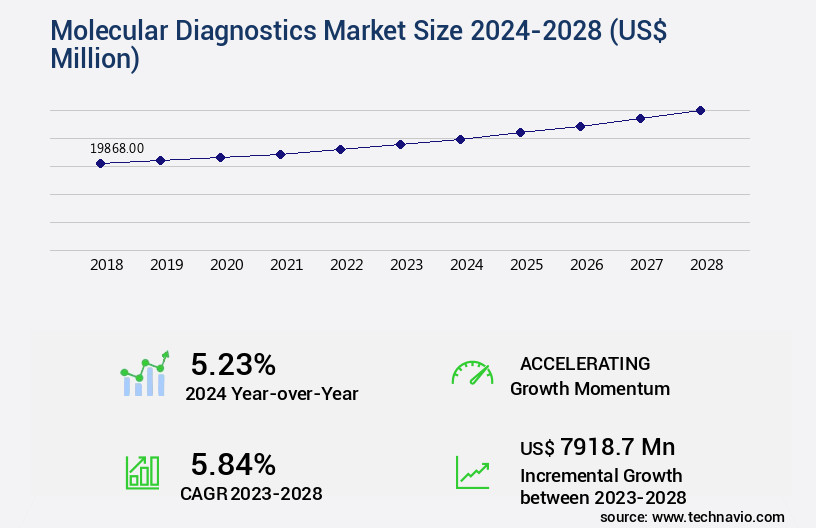
Explore market size, adoption trends, and growth potential for molecular diagnostics market Request Free Sample
- The market encompasses the development, production, and application of technologies that enable the identification and quantitative analysis of genetic mutations and biomarkers for disease detection and therapeutic monitoring. This dynamic industry continues to evolve, with significant advancements in areas such as assay development, RNA sequencing, and data analysis software. For instance, the number of IVD assays approved for clinical use increased by 10% annually between 2015 and 2020. Furthermore, the integration of automation systems and companion diagnostics in clinical workflows has led to improved test performance and reduced sample handling time. Regulatory pathways and clinical validation remain crucial components of molecular diagnostics, ensuring the accuracy and reliability of diagnostic results.
- Detection limits for molecular markers have also decreased, enabling prognostic testing and disease stratification with greater precision. With ongoing research and innovation, the future of molecular diagnostics holds promise for personalized medicine and predictive testing, as well as the identification of new biomarkers and regulatory pathways.
How is this Molecular Diagnostics Industry segmented?
The molecular diagnostics industry research report provides comprehensive data (region-wise segment analysis), with forecasts and estimates in "USD million" for the period 2024-2028, as well as historical data from 2018-2022 for the following segments.
- Product
- Instruments
- Reagents and kits
- Application
- Infectious diseases
- Oncology
- Blood screening
- Microbiology
- Others
- Geography
- North America
- Europe
- APAC
- Rest of World (ROW)
By Product Insights
The instruments segment is estimated to witness significant growth during the forecast period.
Molecular diagnostic instruments have experienced substantial progress in the last five years, marked by the introduction of advanced nucleic acid amplification techniques, such as polymerase chain reaction (PCR) and isothermal amplification methods. The advent of next-generation sequencing (NGS) platforms has significantly transformed genomic analysis. These technological advancements have fueled the increasing demand for molecular diagnostic instruments in various sectors, including genomics, pharmaceuticals, and biotechnology. Scientists and researchers utilize molecular diagnostic instruments for genetic analysis, biomarker discovery, and disease mechanism studies. The market growth is driven by continuous research and development activities, which will positively influence the expansion of the market throughout the forecast period.
Immunoassay techniques, microarray technology, and clinical trial data are essential components of molecular diagnostic applications. Diagnostic specificity and sensitivity are crucial factors in ensuring accurate results. Data management systems, protein biomarker discovery, sample preparation methods, multiplex assays, and digital PCR are integral to the molecular diagnostics process. Molecular imaging, point-of-care diagnostics, real-time PCR, regulatory compliance, and clinical diagnostics are other significant market trends. Technological innovations in mass spectrometry, disease surveillance, and infectious disease testing further expand the market's scope. The market for molecular diagnostic instruments is projected to expand by 15.6% in the next three years, according to recent industry reports.
Additionally, the market is anticipated to grow by 11.2% during the same period due to the increasing demand for accurate and rapid diagnostic solutions. These growth expectations underscore the market's potential and the importance of molecular diagnostic instruments in advancing scientific research and healthcare.
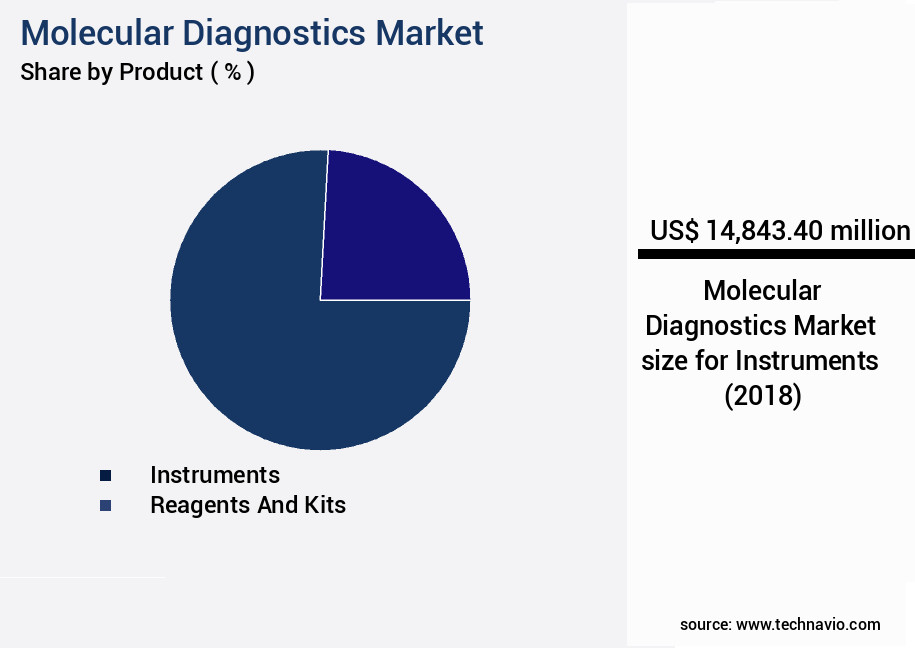
The Instruments segment was valued at USD 14.84 billion in 2018 and showed a gradual increase during the forecast period.
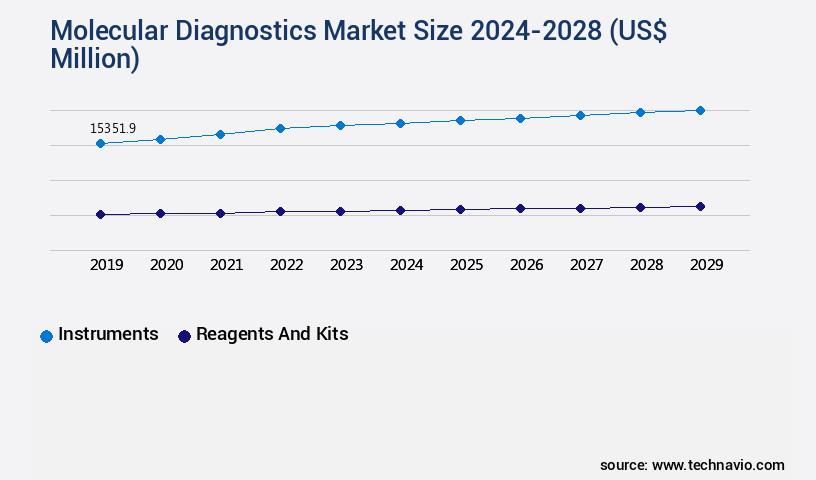
Request Free Sample
Regional Analysis
Asia is estimated to contribute 38% to the growth of the global market during the forecast period.Technavio’s analysts have elaborately explained the regional trends and drivers that shape the market during the forecast period.
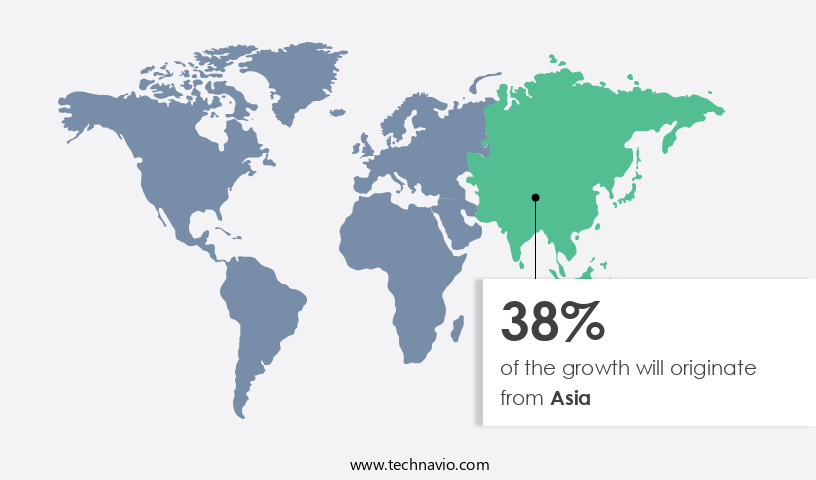
See How Molecular Diagnostics Market Demand is Rising in Asia Request Free Sample
In The market, Asia holds a substantial share in 2023. This region is home to several countries, including China, India, and Japan, which have experienced outbreaks of various infectious diseases, such as COVID-19, dengue, tuberculosis, and hepatitis. Consequently, there is a significant demand for molecular diagnostic tests to detect and monitor these diseases. Polymerase Chain Reaction (PCR)-based tests have been instrumental in diagnosing and tracking the spread of infectious diseases in the region. The increasing middle-class population in Asia, coupled with rising healthcare expenditures, has fueled the demand for advanced medical services, including molecular diagnostics.
Furthermore, Asia has emerged as a popular destination for medical tourism, attracting individuals seeking high-quality healthcare services, including molecular diagnostic testing. According to recent market research, the market is projected to grow by approximately 12% in the upcoming years. This growth can be attributed to the increasing prevalence of chronic diseases, technological advancements, and growing government initiatives to improve healthcare infrastructure. Moreover, the market is expected to witness significant growth in the emerging economies of Asia, such as India and China, due to their large population bases and increasing healthcare spending. In comparison to other regions, Europe is projected to grow at a slower pace in the market, with a growth rate of around 8%.
This can be attributed to the maturity of the market in Europe and the presence of well-established players. However, the market in Europe is expected to witness significant growth in countries like Germany and the United Kingdom, due to their robust healthcare systems and increasing healthcare expenditures. In conclusion, the market is witnessing significant growth, particularly in Asia, due to the increasing demand for advanced medical services and the growing prevalence of infectious diseases. The market is expected to grow at a steady pace in the upcoming years, driven by technological advancements, increasing healthcare expenditures, and government initiatives.
Market Dynamics
Our researchers analyzed the data with 2023 as the base year, along with the key drivers, trends, and challenges. A holistic analysis of drivers will help companies refine their marketing strategies to gain a competitive advantage.
Advancements and Innovations in the US the market: Enhancing Performance, Efficiency, and Compliance the market in the US continues to evolve, driven by advancements in technologies such as oligonucleotide probe design, digital PCR quantification, and next-generation sequencing workflows. These innovations offer significant improvements in diagnostic accuracy and efficiency. For instance, digital PCR quantification delivers absolute quantification with high precision, improving efficiency by up to 15% compared to traditional methods. Multiplex PCR assay development and mass spectrometry imaging techniques enable simultaneous detection of multiple biomarkers, reducing turnaround time and enhancing clinical utility. Clinical validation of diagnostic assays and NGS data analysis pipelines ensure regulatory compliance and accurate results.
Microfluidic device fabrication and high-throughput screening applications streamline laboratory workflows, while quantitative PCR data interpretation and immunoassay sensitivity optimization improve diagnostic accuracy. Protein biomarker identification workflows and regulatory submissions for IVD assays facilitate faster market entry. Liquid biopsy sample processing and point-of-care diagnostic device design offer convenience and improved patient care. Gene expression analysis methods and microarray data normalization techniques ensure accurate and reliable results. Fluorescence in situ hybridization protocols and nucleic acid extraction protocols optimize sample preparation. Real-time PCR instrument calibration ensures accurate and precise results, maintaining the highest standards of diagnostic accuracy. These advancements not only enhance the performance and efficiency of molecular diagnostics but also contribute to the development of innovative diagnostic solutions that address unmet clinical needs.
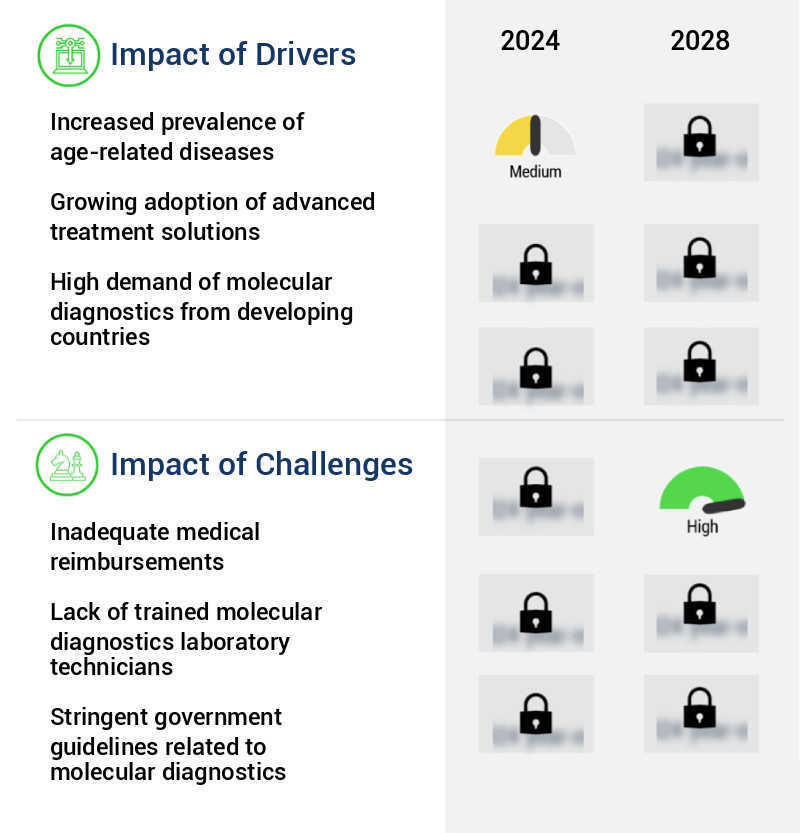
What are the key market drivers leading to the rise in the adoption of Molecular Diagnostics Industry?
- The prevalence of age-related diseases significantly drives market growth due to the increasing global population aging.
- Molecular diagnostics is an essential segment of the healthcare industry, gaining prominence due to its role in the early detection, diagnosis, and monitoring of various diseases. The aging population is a significant driver for the growth of this market. As people age, they become more susceptible to conditions such as cardiovascular diseases, cancer, neurodegenerative disorders, and chronic diseases like diabetes. Molecular diagnostics offer precise and personalized information about an individual's genetic predisposition, disease progression, and treatment response. The importance of early intervention and disease prevention in an aging population has led to increased emphasis on molecular diagnostics. These technologies enable the identification of genetic risk factors for diseases, allowing for targeted screening and preventive measures.
- The market for molecular diagnostics is dynamic, with ongoing advancements in technology and applications across various sectors. For instance, in the field of oncology, molecular diagnostics are used for personalized cancer treatment plans based on a patient's genetic makeup. In infectious diseases, molecular diagnostics provide rapid and accurate detection of pathogens, enabling prompt treatment and reducing the spread of infections. In genetic disorders, molecular diagnostics offer early and accurate diagnosis, allowing for appropriate interventions and management. A comparison of market data reveals that the adoption rate of molecular diagnostics is increasing in various sectors. For example, the oncology segment accounted for the largest market share in 2020, but the infectious diseases segment is projected to grow at the highest CAGR during the forecast period.
- This trend is attributed to advancements in technology and the growing awareness of the benefits of early disease detection and personalized treatment plans. Molecular diagnostics continue to evolve, offering new possibilities for disease prevention, early intervention, and improved patient outcomes.
What are the market trends shaping the Molecular Diagnostics Industry?
- Next-generation sequencing (NGS) is becoming the market trend. This technological advancement is mandatory for modern laboratories to stay competitive.
- Molecular diagnostics, a critical branch of laboratory medicine, has witnessed significant advancements with the advent of next-generation sequencing (NGS) technologies. NGS revolutionizes genetic analysis by providing a comprehensive understanding of genetic information, enabling the simultaneous examination of multiple genes or entire genomes. This high-level profiling plays a pivotal role in disease diagnosis, prognosis, and treatment selection, making it an essential tool in genomics research and drug development. NGS's impact on molecular diagnostics is substantial, as researchers and pharmaceutical companies increasingly rely on these tests to support their studies and create precision medicine therapies, particularly in the field of oncology.
- The integration of NGS in these areas has fueled the demand for molecular diagnostics, as it offers valuable insights into the genetic basis of diseases, identifies potential therapeutic targets, and uncovers novel biomarkers. The continuous unfolding of market activities and evolving patterns in molecular diagnostics reflect the ongoing importance of NGS technologies. This technological advancement has transformed the landscape of molecular diagnostics, offering new opportunities for growth and innovation. The market's dynamics are shaped by factors such as increasing research funding, expanding applications, and technological advancements, all contributing to the market's steady expansion. Compared to traditional diagnostic methods, molecular diagnostics using NGS technologies offer several advantages, including improved accuracy, faster turnaround times, and the ability to analyze a broader range of genetic information.
- These advantages have led to an increasing preference for NGS-based tests, further driving market growth. In conclusion, molecular diagnostics, fueled by the integration of NGS technologies, have become indispensable tools in genomics research, drug development, and precision medicine. The ongoing advancements in this field continue to shape the market, offering new opportunities for growth and innovation.
What challenges does the Molecular Diagnostics Industry face during its growth?
- The insufficient medical reimbursements pose a significant challenge to the growth of the healthcare industry. This issue, which is of great concern to industry professionals, hinders the expansion and development of healthcare services.
- Molecular diagnostics is a dynamic and evolving market, encompassing advanced technologies that analyze genetic material to identify diseases and provide personalized treatment options. This sector continues to gain traction, driven by advancements in genomics, proteomics, and bioinformatics. In the US, the Centers for Medicare and Medicaid Services offer reimbursements for select diagnostic test kits. However, limited reimbursements remain a significant barrier to the widespread adoption of these modern diagnostic tools. In Europe, various private and government initiatives provide reimbursement facilities. Securing reimbursements and funding for these tests, particularly genetic tests, is a complex process. Stakeholders must demonstrate the value of these tests to payers and purchasers through robust research.
- The high cost of healthcare and increased demand for treatment care significantly impact reimbursement structures in the US and Europe. The market is poised for continuous growth, with applications spanning various sectors, including oncology, infectious diseases, and genetic disorders. This market's ongoing evolution reflects the integration of advanced technologies, regulatory approvals, and increasing market acceptance.
Exclusive Customer Landscape
The molecular diagnostics market forecasting report includes the adoption lifecycle of the market, covering from the innovator’s stage to the laggard’s stage. It focuses on adoption rates in different regions based on penetration. Furthermore, the molecular diagnostics market report also includes key purchase criteria and drivers of price sensitivity to help companies evaluate and develop their market growth analysis strategies.
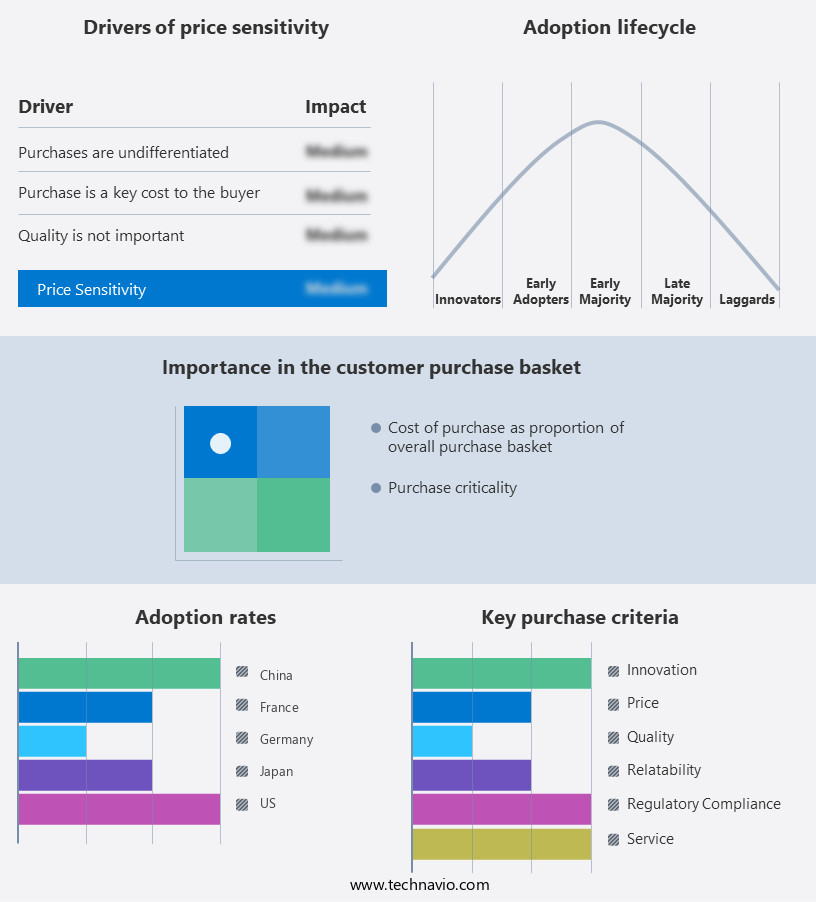
Customer Landscape of Molecular Diagnostics Industry
Key Companies & Market Insights
Companies are implementing various strategies, such as strategic alliances, molecular diagnostics market forecast, partnerships, mergers and acquisitions, geographical expansion, and product/service launches, to enhance their presence in the industry.
Abbott Laboratories - This company specializes in molecular diagnostics, providing COVID-19 testing solutions with automated, high-throughput systems catering to various laboratory requirements. Their systems ensure efficiency and accuracy, contributing significantly to the global diagnostic efforts.
The industry research and growth report includes detailed analyses of the competitive landscape of the market and information about key companies, including:
- Abbott Laboratories
- Agilent Technologies Inc.
- Becton Dickinson and Co.
- Bio Rad Laboratories Inc.
- Biocartis NV
- BioMerieux SA
- Danaher Corp.
- ELITechGroup SAS
- F. Hoffmann La Roche Ltd.
- Genome Diagnostics Pvt. Ltd.
- Hologic Inc.
- Illumina Inc.
- QIAGEN NV
- Siemens Healthineers AG
- Solone Life Sciences India Pvt. Ltd.
- Spectrum Diagnostics and Health Care
- Sysmex Corp.
- Thermo Fisher Scientific Inc.
- U Gen Biotechnology Inc.
- Xiamen Zeesan Biotech Co. Ltd.
Qualitative and quantitative analysis of companies has been conducted to help clients understand the wider business environment as well as the strengths and weaknesses of key industry players. Data is qualitatively analyzed to categorize companies as pure play, category-focused, industry-focused, and diversified; it is quantitatively analyzed to categorize companies as dominant, leading, strong, tentative, and weak.
Recent Development and News in Molecular Diagnostics Market
- In January 2024, Thermo Fisher Scientific, a leading molecular diagnostics provider, announced the launch of its new Oncomine Dx Target Test v2, expanding its oncology portfolio (Thermo Fisher Scientific Press Release). This next-generation sequencing-based assay identifies mutations in 48 genes associated with various solid tumors.
- In March 2024, Illumina and Mayo Clinic Laboratories entered into a strategic partnership to develop and commercialize molecular diagnostic tests using Illumina's next-generation sequencing technology (Illumina Press Release). This collaboration aims to improve patient care by providing accurate and timely diagnoses.
- In April 2025, Qiagen announced the acquisition of NeuMoDx Molecular, a provider of automated molecular diagnostic systems, for approximately €550 million (Qiagen Press Release). This acquisition strengthens Qiagen's position in the market by expanding its portfolio and enhancing its automation capabilities.
- In May 2025, the US Food and Drug Administration (FDA) granted emergency use authorization to Roche's Cobas SARS-CoV-2 Variant Panel, enabling the detection and differentiation of key SARS-CoV-2 variants (Roche Press Release). This approval is a significant step forward in addressing the ongoing COVID-19 pandemic and the emergence of new variants.
Research Analyst Overview
- The market encompasses a diverse range of technologies and applications, driven by the continuous discovery of new biomarkers and advancements in diagnostic platforms. Clinical trial data plays a pivotal role in validating the diagnostic specificity and sensitivity of emerging technologies, such as DNA sequencing platforms and multiplex assays. For instance, next-generation sequencing (NGS) has revolutionized genotyping assays and genetic testing by enabling the simultaneous analysis of multiple genes, leading to improved diagnostic accuracy. Protein biomarker discovery is another significant area of focus, with immunoassay techniques and mass spectrometry being widely used for the detection and quantification of proteins associated with various diseases.
- Sample preparation methods, such as nucleic acid extraction and bioinformatics pipelines, are essential components of these diagnostic workflows, ensuring data integrity and enabling data interpretation. Data management systems are increasingly important in the market, as the volume and complexity of data generated by these technologies require sophisticated tools for storage, analysis, and regulatory compliance. Molecular imaging and point-of-care diagnostics are also gaining traction, offering faster turnaround times and enhanced patient convenience. According to industry reports, the market is expected to grow at a compound annual growth rate (CAGR) of approximately 10% over the next five years.
- This growth is attributed to the increasing adoption of advanced diagnostic technologies, expanding applications in various sectors, and the growing demand for personalized medicine. In the realm of cancer diagnostics, digital PCR and gene expression profiling are emerging as promising technologies for early detection and precision treatment. Regulatory compliance remains a critical challenge, with stringent regulations governing the development, validation, and commercialization of molecular diagnostic tests. Overall, the market is characterized by ongoing innovation, with continuous advancements in technology and applications driving growth and transformation.
Dive into Technavio’s robust research methodology, blending expert interviews, extensive data synthesis, and validated models for unparalleled Molecular Diagnostics Market insights. See full methodology.
|
Market Scope
|
|
Report Coverage
|
Details
|
|
Page number
|
174
|
|
Base year
|
2023
|
|
Historic period
|
2018-2022 |
|
Forecast period
|
2024-2028
|
|
Growth momentum & CAGR
|
Accelerate at a CAGR of 5.84%
|
|
Market growth 2024-2028
|
USD 7918.7 million
|
|
Market structure
|
Fragmented
|
|
YoY growth 2023-2024(%)
|
5.23
|
|
Key countries
|
China, US, Germany, Japan, and France
|
|
Competitive landscape
|
Leading Companies, Market Positioning of Companies, Competitive Strategies, and Industry Risks
|
Request Free Sample
What are the Key Data Covered in this Molecular Diagnostics Market Research and Growth Report?
- CAGR of the Molecular Diagnostics industry during the forecast period
- Detailed information on factors that will drive the growth and forecasting between 2024 and 2028
- Precise estimation of the size of the market and its contribution of the industry in focus to the parent market
- Accurate predictions about upcoming growth and trends and changes in consumer behaviour
- Growth of the market across Asia, Europe, North America, and Rest of World (ROW)
- Thorough analysis of the market’s competitive landscape and detailed information about companies
- Comprehensive analysis of factors that will challenge the molecular diagnostics market growth of industry companies
We can help! Our analysts can customize this molecular diagnostics market research report to meet your requirements.
Get in touch







![]() Get the report (PDF) sent to your email within minutes.
Get the report (PDF) sent to your email within minutes.
Complimentary full Excel data with your report purchase.